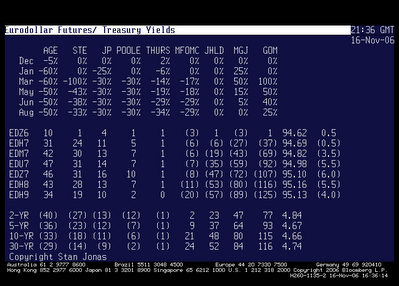The market, in its infinite wisdom, ignores the softness that permeated the data this week and instead focused on the FOMC minutes. Minutes from a meeting that took place three weeks ago and made note of the important information coming out between then and the Dec meeting. Shouldn't Poole's comments these past several days have more impact than the minutes?
Apparently not. A week ago, the Mar 07 Eurodollar contract was priced to a 26% chance of an ease and now sits at 14%. Odds of a move in Jan is down to 6%. The Mar contract is interesting because it contains an expectation of what will have happened in Jan and what it thinks the market will think what will happen in the 3 months to follow. Below is how the probabilities shake out as of today's close (courtesy of Stan Jonas) and the impact of a shift in expectations on prices and yields. The later in the year we go, the odds of an ease move higher -- so says the market.
The pricing is skewed the wrong way, from my perspective. Odds of an ease in January is really quite high -- if the eco bears get the kind of 4th quarter economy they expect. The Fed will be sifting through 4th quarter data that are coming on the heels of a weak 3rd quarter. The cumulative impact of 5.25% funds will be obvious. On the other hand, if the Fed holds in Jan, that 4th quarter bounce the FOMC expects will have occurred. If we get the bounce, that market-determined cumulative probability of an ease in the spring and again later in the year will likely swing to a bias to tighten.
Right now, the 2-year has 23 basis points of risk should the probabilities swing back to 0% (on hold). On the other hand, a Jan ease gives the 2-year a 40 basis point rally. Pick your bias, know your risk, the tale will be told by Jan. And maybe, just maybe, hinted at in the Dec statement. Stay tuned.

No comments:
Post a Comment